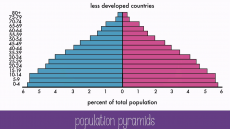

What is population dynamics?
Population dynamics is the branch of life sciences that studies the size and age composition of populations as dynamical systems, and the biological and environmental processes driving them (such as birth and death rates, and by immigration and emigration).
Why is understanding population dynamics important?
it is our future
To understand how to live sustainably
Allows for decision making for the present and future
Allows us to compare the current status to the past
Population size influences demand for resources
Population size can have effects on climate change
Key terms
Birth rate- number of live births every year per 1,000 of the population
Death rate- number of people who die every year per 1,000 of the population
Migration- when people move from one place to another for more than one year
Natural increase- this is the difference between the birth and death rates
Annual population- this can be positive or negative and it is an areas growth over the course of a year
The global population continues to increase, but its distribution across the face of the earth is changing. Places in Africa and Asia have increased massively. Many of these countries within these continents are less economically developed and a lot of religions and cultures take okay enthuse countries where it is a good thing to have lots of children. In some countries children may be needed to work. More economically developed countries tend to have more technology, so there is not necessarily a need for mass employment, but having a lot of children would be significantly more expensive.
Populations are expected to increase if there is better access to healthcare and technology, more women seeking careers and thus having less children (or having children later in life), if a one child policy is introduced and if the expense of children continues to rise.
The most important characteristics are age and gender. These can be shown in a population pyramid. It can help us to forecast future population structures.
Dependent population- a population who depends on the economically active for support
Economically active- those who are working age
Life expectancy- the age you are expected to live until
Dependency ratio- how many dependents depend on the economically active
When a country is underpopulated the general trend is that there are few people and lots of resources. When a country is over populated, there tends to be far too many people and not enough resources. The optimum population would have the correct number of people for the resources available. The tipping point is the point at which the momentum of change becomes unstoppable, either when the population becomes under populated or over populated.
How can you effect the population of a country?
controlling the amount of births taking place
Encouraging migration
Unemployment and food
Better healthcare
Making having children more expensive
What are the issues here?
over populating over countries
Couch get forced to get rid of children
People not being used to different climate
People not being used to other countries ways of living
Language communication problems
Money problems
Could effect poverty levels

0 Comment:
Be the first one to comment on this article.